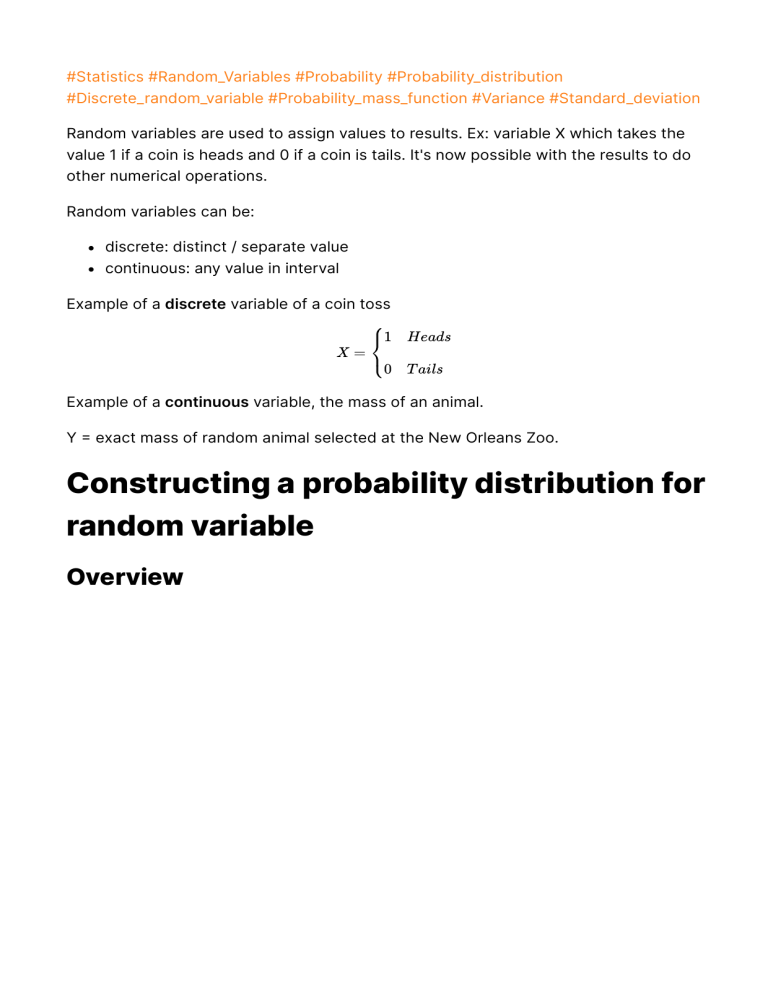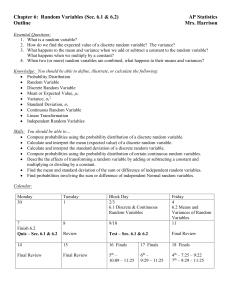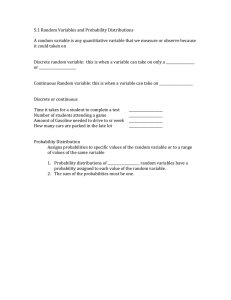
#Statistics #Random_Variables #Probability #Probability_distribution #Discrete_random_variable #Probability_mass_function #Variance #Standard_deviation Random variables are used to assign values to results. Ex: variable X which takes the value 1 if a coin is heads and 0 if a coin is tails. It's now possible with the results to do other numerical operations. Random variables can be: discrete: distinct / separate value continuous: any value in interval Example of a discrete variable of a coin toss ⎧1 X = ⎨ ⎩ 0 H eads T ails Example of a continuous variable, the mass of an animal. Y exact mass of random animal selected at the New Orleans Zoo. Constructing a probability distribution for random variable Overview A probability distribution for a discrete random variable is also called a Probability Mass Function or PMF. How to construct one How to interpret one Consider the example above. Rolling a 6 side die gives a 1/6 chance of getting one side. So, the chance to get a value from 1 to 6 is 1/6. The Cumulative distribution function CDF shows the cumulative probabilities. For ex, if you want to know what's the probability of getting a 4 or less, you need to sum up all the probabilities from 1 to 4. Probability models example Valid discrete probability distribution model A valid model has to respect the following conditions all the probabilities have to add up to 1 or 100% ∑ f (x) = 1 x no negative values (you cannot have negative probabilities) f (x) ≥ 0 Example: Probability with discrete random variable example In the following example, what's the percentage that Hugo will reach 4 packs bought in order to get his card. Mean (expected value) of a discrete random variable The expected value is noted as E(x) or as μx . The following example shows how to get the expected value of x given the probability table below. The 2.1 workouts would mean that in 10 weeks, it's expected to do 21 workouts. In some weeks, it might be 1, in others 4, but the total should come close to 21 in 10 weeks. The general intuition is the following. If you do X amount of activities with their probabilities, if it's done a lot of times, the average will fall around a certain value. So, the formula for multiple events becomes: E(x) = ∑ X ∗ P (X) Standard deviation of a discrete random variable The variance of a discrete random variable is calculated as: n 2 s x = ∑ ((X i − μ x ) 2 × Px ) i=1 The standard deviation of a discrete random variable is calculated as: σx = √s 2 = x Sources: n ∑ ((X i − μ x ) 2 × P x ) ⎷ i=1 Statistics and Probability _ Khan Academy @zedstatistics - YouTube





